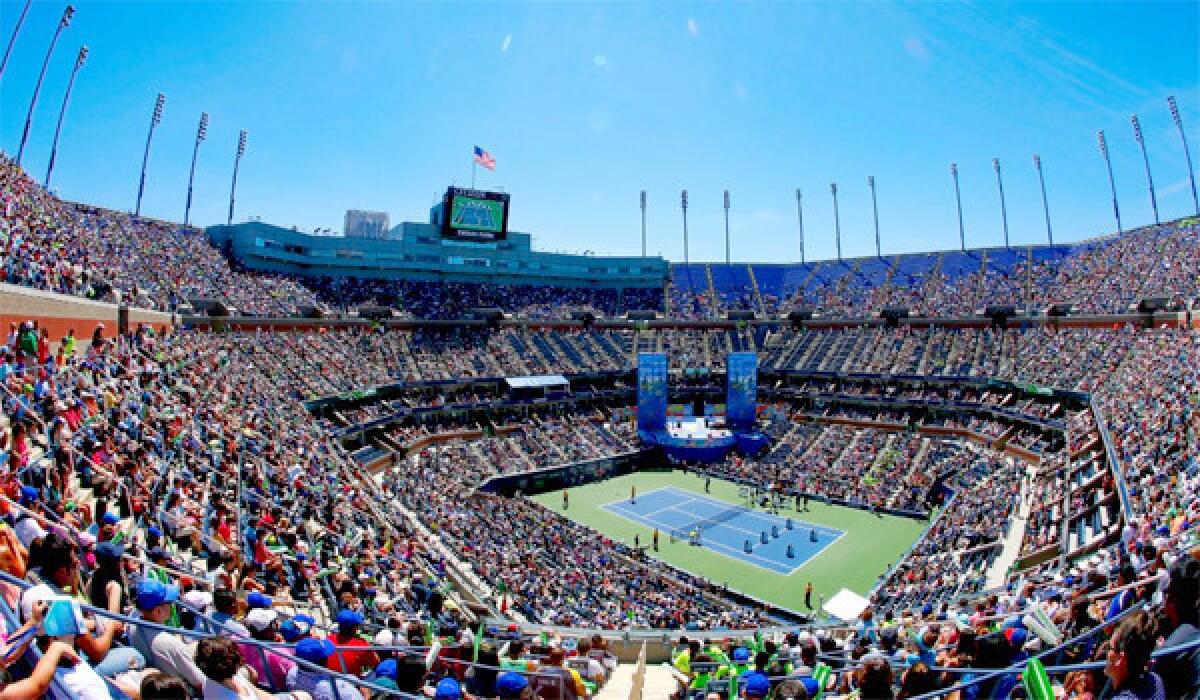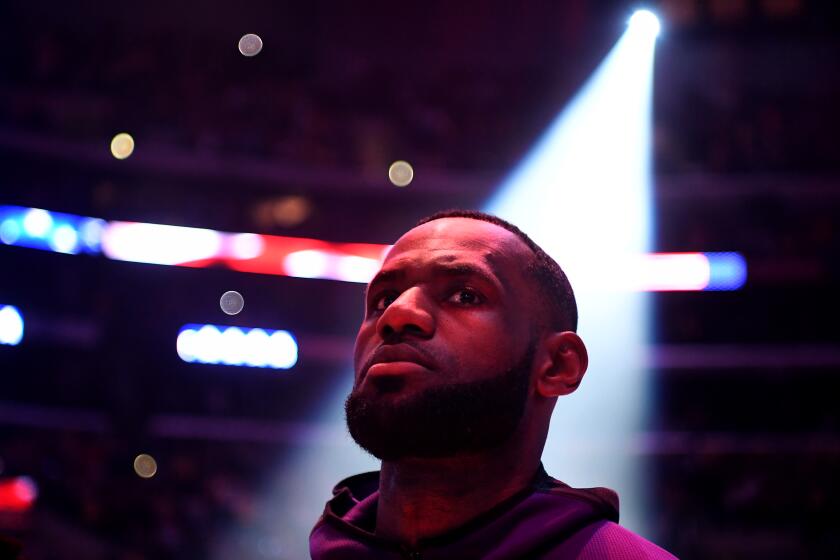What’s happened to serve and volley in tennis?

- Share via
NEW YORK — The contrasts used to be one of the most attractive elements of tennis.
Pete Sampras standing at the net, Andre Agassi at the baseline trying to get the ball past his greatest rival.
Chris Evert, dainty but cruelly clever in the backcourt, against Martina Navratilova, who moved forward, fast as a whip, knocking a volley that Evert lunged at or just missed, eliciting a squeak of frustration from Evert.
Or John McEnroe, dancing on his toes, back and forth as Bjorn Borg stood at the back of the court and calculated the correct angle at which to whiz the ball past his rival — only to have McEnroe, with a flick of the wrist, gently drop the ball over the net, just in the spot where Borg couldn’t reach it.
Billie Jean King still volunteers to coach players and teach them to serve and volley. She urged Serena and Venus Williams to learn that most difficult part of the game but couldn’t persuade either of them.
As the U.S. Open tennis tournament, the final major of the year, begins Monday, it’s more likely viewers will see an American man win — a longshot — than see more than a handful of serve-and-volley points.
That part of the game is gone, possibly forever.
“I don’t think it’s ever coming back, I really don’t,” said Sampras, who won 14 Grand Slam events, second only to Roger Federer. “It’s difficult to learn to do, and it’s hard to be successful with it at first, and kids and coaches don’t like failure....
“You have to be a good athlete, have great hands and great feet. The shot itself is pretty easy, but you need good touch and an intuition as to where the ball is going to go. You need to know when to run slow, run fast. All that stuff has to be learned.”
Lindsay Davenport, who won three Grand Slam events, agreed with Sampras. “Yes,” she said, “that part of the game is gone and probably for good. I guess you should never say never, but I’d say never.”
Davenport, as did Sampras and as have many players over the last decade, said technology is part of the reason.
“Improvements in strings, in rackets, it’s taken some of the purity out of the game,” Davenport said. “You need such great technique, precise footwork, great anticipation and good form that holds up under pressure. So many things go into serve and volley, and players aren’t being taught to be so precise. They don’t need to be.
“With the strings we have now, you can hit bad shots from the baseline and the ball still goes in. I find myself shaking my head sometimes wondering how a ball landed in.”
McEnroe, considered by many to have been the best in the game at volleying, echoed Davenport. “The better rackets is one thing, the strings; the courts are slower in general.
“If you’ve noticed, the U.S. Open courts play fairly quickly. It would be a perfect court for someone like Sampras or [Stefan] Edberg or myself to be able to do their thing on the quicker court.
“When I’m asked this question, it always makes me think back to when Wimbledon was all about serve and volley and Pete was winning, Boris [Becker] and Goran Ivanisevic.
“All of a sudden, the game became a baseline game, and Lleyton Hewitt was playing David Nalbandian. I would have bet everything, my house, that you would never see that type of tennis in the men’s game where all the players are staying back. I would have lost my house.
“I think ideally the best tennis is when you have two different styles going at it. People enjoy that more.”
A couple of weeks ago, Li Na, seeded sixth at the Open, played top-ranked Serena Williams in Cincinnati. Before the match, Li told Pam Shriver, “I’m going to serve and volley. I’m going to try something different.”
Williams won; Li served and volleyed fewer than 10 times.
“The key point is to keep people off balance,” McEnroe said. “I’m not even suggesting someone like John Isner, who has a huge serve, has to do it on every point. But try it sometimes. What about like one or two points? When you serve that big, it’s just amazing to see someone not come in after it.
“Sampras, even though he was a measly 6-1, was so good at it. He got people totally out of rhythm and totally uncomfortable and did his thing.”
Cliff Drysdale, a former top-10 player and broadcaster for ESPN, said we’ve seen the last of the traditional serve-and-volley game.
“You’ll have the occasional player who uses the serve to get in as a changeup,” he said, mentioning Federer as being good at that.
“You’ve got guys like Rafael Nadal, and against his returns, there is no prospect of being able to serve and volley. We’ve got some big guys out there like John Isner, Kevin Anderson, Milos Raonic who can serve, but that doesn’t mean they can volley.
“But be careful what you wish for. In my day, courts were so bad we’d do it just to try and end the point before we got a bad bounce. But really, it’s hard to do, it takes a lot of practice, it’s not coached.
“It’s too bad because you always want variety.”
Dennis Novikov, who played at UCLA before turning pro last year, said no coach had even suggested he learn to serve and volley.
“With the rackets and strings now making the game so much more physical and faster, it’s hard to come to the net,” Novikov said. “I was never taught it. I don’t think it will come back, ever.”
Serve and folly. That’s what it should be called now. Because, as Sampras said, serve and volley? “That’s extinct.”
Twitter: @mepucin
More to Read
Go beyond the scoreboard
Get the latest on L.A.'s teams in the daily Sports Report newsletter.
You may occasionally receive promotional content from the Los Angeles Times.










